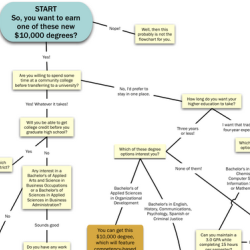
The idea of a degree with a price tag one-fifth the cost of the average public, in-state college degree likely sounds appealing. After all, tuition for public universities is rising about 8 percent each year, according to a recent study by the State Higher Education Executive Officers Association. Earning a college education is more expensive than ever, while financial aid continues to shrink. But as the saying goes, "if it sounds too good to be true, it probably is," and the $10,000 degree is no exception.
A Look Back
The idea of a bachelor's degree for $10,000 seems to have roots in an informal comment that Bill Gates made back in 2010. He said that new technological innovations in higher education should make it possible for a student to pay $2,000 per year in tuition. From there, some have taken the idea of $2,000 tuition, multiplied it by five (the average number of years it now takes a student to earn a bachelor's degree) and come up with the idea that a college degree should cost no more than $10,000. Governors in Texas, Wisconsin and Florida liked the sound of the cheap degree and have since challenged the public colleges in their states to create a pathway for students to earn a bachelor's degree for this reduced price. Schools in each state have taken the challenge and come up with a variety of programs to reach this goal.
Why is the $10,000 degree a myth?
If after reading about the roots of the degree program you feel that the arrival at the $10,000 price-tag was a bit arbitrary, you are right. The decision to create a degree for less than one-fifth the price of an average in-state, public-school degree was not based on the feasibility to create a cheaper college experience. Instead, the price tag was arrived at based upon a taken-out-of-context comment from Bill Gates.
While the idea of a $10,000 degree sounds great, the reality of such a ridiculously cheap degree is not quite so bright. In Texas, there are thirteen $10K-degree options. Most involve students earning a significant number of AP credits during high school and attending a community college before arriving at a university. Other $10K-degree programs subtract Pell Grants or scholarships (funded by other student's full-priced tuition) in order to plumb the lowest possible cost.
All of these programs are offered in very narrow specialties -- Information Technology with a focus on security, Business Administration, nursing, among select others -- to students who make the choice of what to study while still in high school. With so many barriers to entry, the $10,000 degree is simply not an option for the majority of students.

Even if colleges are able to find ways to offer the reduced tuition programs to a larger number of students, there are still some problems with the degrees. For one, the $10K price tag does not take into consideration the cost of textbooks or course fees -- costs that can be significant for students. Additionally, some of the $10K programs have already started to see a need to increase tuition. For example, the IT degree offered by Alamo College and Texas A&M University-San Antonio has already seen its price inflate to slightly ABOVE $10K before graduating one student.
The biggest problem with the $10,000 degree is in the programs' creation. Rather than subsidizing degrees or incentivizing genuine innovation in education, states are asking colleges to race to the bottom. The $10,000 is effectively a promotional tool that can be used by the college or states who want to claim that they are reducing tuition. The goal is noble, but talk of the $10,000 degree overhypes the number of students helped by the creation of these programs. The $10K BA is not available for the majority of those pursuing a college education, many of whom also need a more affordable option. These programs pass on the cost-cutting to community colleges, high schools, and other students.
So…What Works?
The effort by governors and educators to significantly reduce tuition to an affordable price is commendable. Colleges have had to get creative in order to find affordable pathways to a degree. The $10K BA has encouraged colleges to accept new forms of learning (like online courses and competency evaluations). Partnerships between community colleges and universities have been strengthened, and credit-transfers between these different institutions have become easier. These are all inventive methods of reducing costs that can be applied outside the $10K-BA program and made available to the greater college-going public.
While there are obvious limitations to the $10,000 degree, if cost-reducing lessons can be learned and then applied to the educational system as a whole, this will all be time well spent. Colleges and states need to shift focus away from creating superaffordable degree programs for the few, and look at ways to reduce cost and achieve affordability for all. With some creativity and effort, maybe one day the $10,000 degree will be more than a myth.
